“Whenever you switch back to your pick, it’ll be even more fun to have its signature attack back”: There’s a reason everyone from Eddie Van Halen to Lindsey Buckingham and Mark Knopfler have made fingerstyle part of their repertoire
Fingerstyle playing can be used in a wide variety of settings and genres, and can inspire new songs, riffs, and solos. Heck, it can even boost your creativity when you return to using a pick

In the first part of this lesson, we set our picks down to learn new fingerstyle skills we can add to our arsenal of electric guitar techniques. We covered the basics, then left off by introducing harp harmonics. In this follow-up, we’ll integrate them into our fingerstyle playing in some fun ways.
Once again, New York City fingerstylist Gilber Gilmore is back with more videos that demonstrate each of our musical examples, all which you can find below.
Jazz guitar legend Lenny Breau was the first to incorporate harp harmonics in a most unique way, by creating melodies that alternate them with standard fretted pitches.
Inspired by Breau, Ex. 7a does just that, and while bar 1 has some standard fingerpicking, it’s the second bar where things get interesting. The key here is to silently form the Dm11 chord shape that’s spelled out in the bar before you play beat 1. (Notice how the final open A note in bar 1 buys you valuable time to move up to the 5th position.)
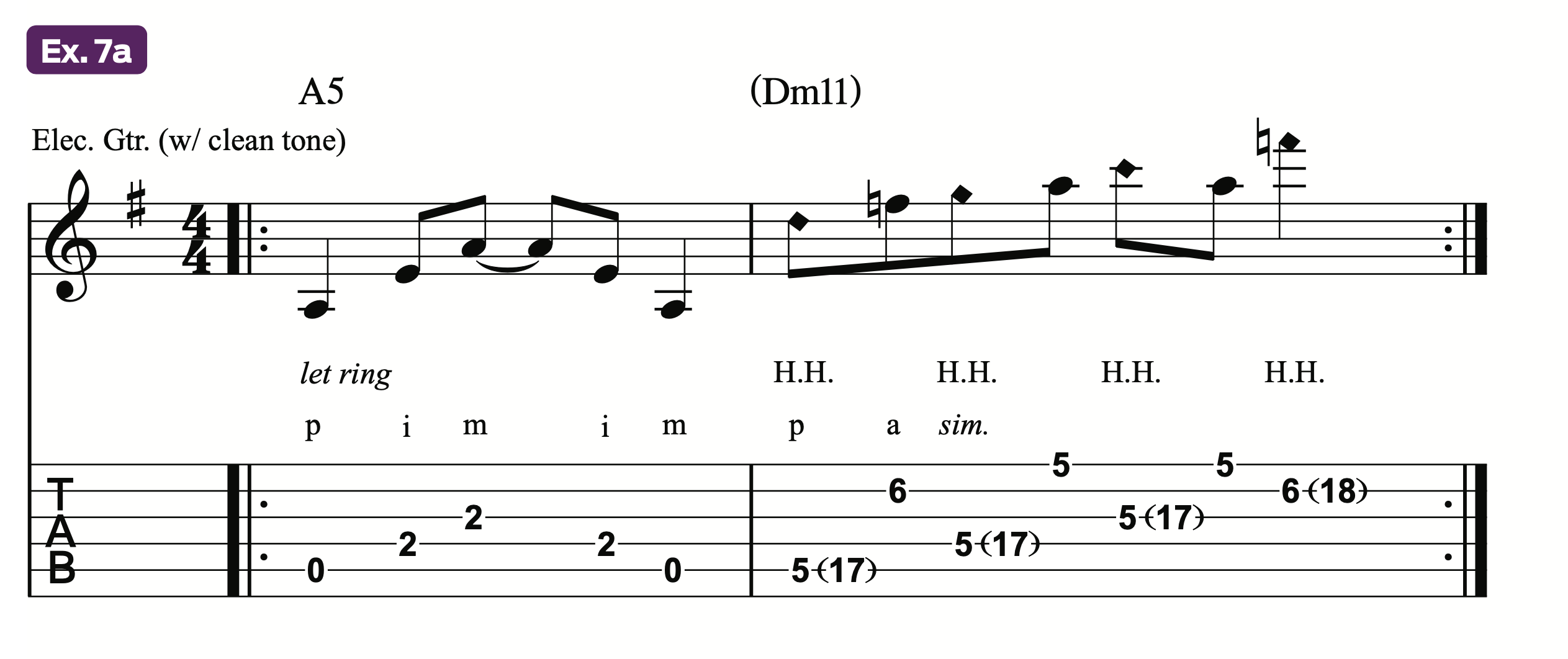
To do this, barre the highest five strings at the 5th fret with your index finger, adding F on the 2nd string’s 6th fret with your middle finger. Holding this shape throughout the bar will allow the notes to ring over one another, which is what we’re going for here.
To begin bar 2, perform the first harp harmonic by picking the 5th string while lightly touching directly over the 17th fret, as indicated in parentheses, then use your ring finger to pick the aforementioned F on the 2nd string. The effect produced is a shimmering scalar passage, which would be pretty much impossible to create on guitar without the use of harmonics.
This sort of musical idea would be right at home in a rock setting, possibly as a pensive intro or a cool breakdown section. (Employ a delay effect to create even more ethereal sounds.)
Ex. 7b offers a nifty variation in which you will simultaneously play a harp harmonic and a fretted note on nonadjacent strings. You’ll need to coordinate your pick-hand techniques to simultaneously pluck the harp harmonic with your thumb on the lower string while picking the fretted note on the higher string with your ring finger. Experimenting with different chord shapes and picking patterns is a fun way to discover some interesting musical ideas of your own.
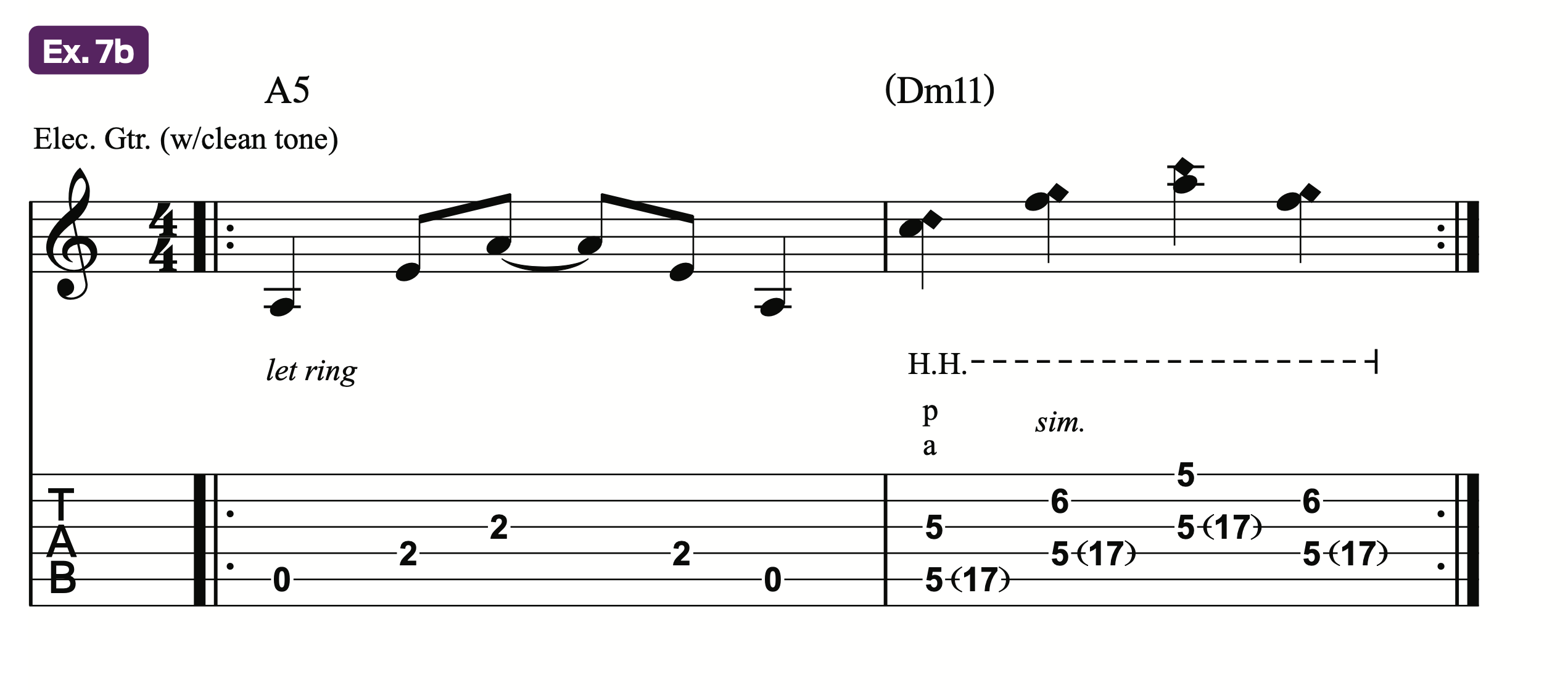
Next, let’s tie the use of harmonics even closer to fingerstyle rock guitar by imagining how Eddie Van Halen might have used harp harmonics. (He actually preferred a different technique, which we’ll explore next.)
Ex. 8 is reminiscent of EVH’s Van Halen II–era playing, and mixes some open A5 riffing with a couple of neatly placed harp harmonics to spice things up at the end.
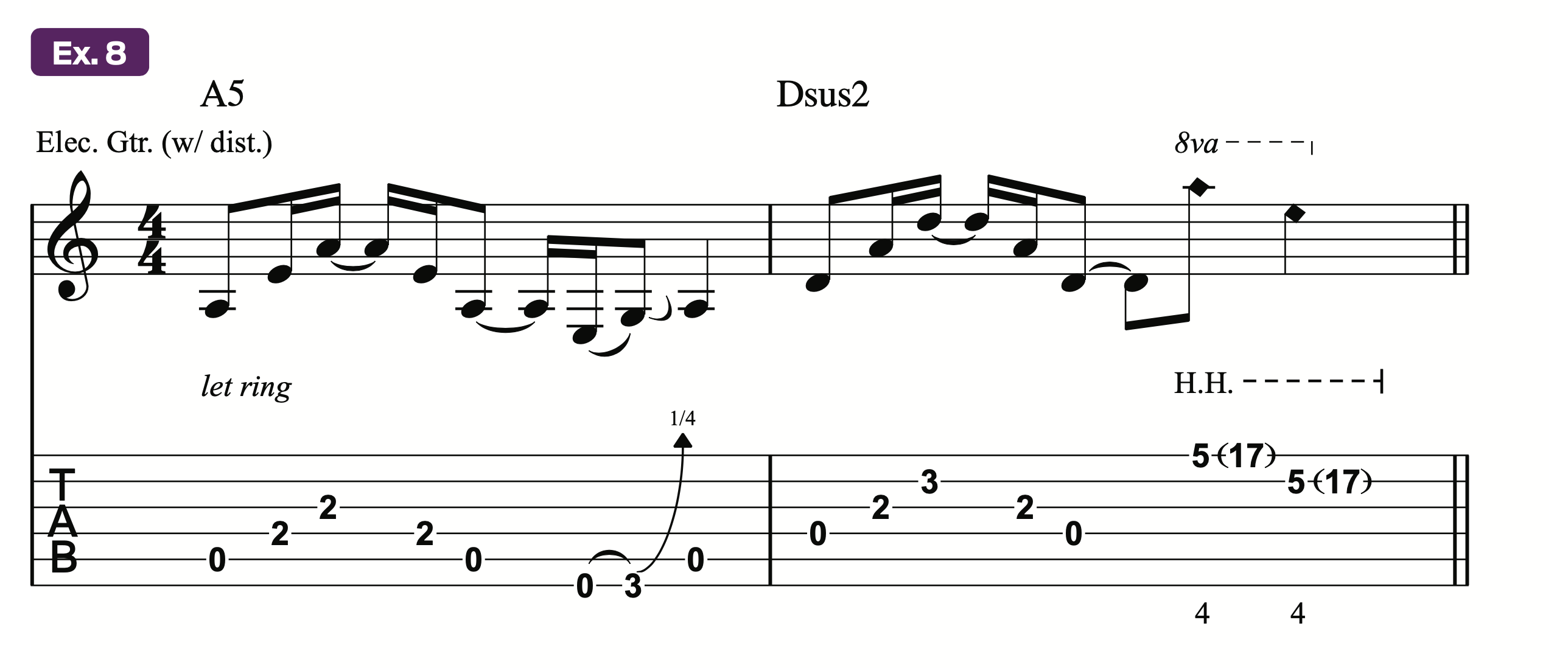
Let’s stay in solid Van Halen territory a little while longer and explore a technique EVH was quite fond of: tapped harmonics.
While this involves the same basic principle of locating harmonics 12 frets above the fretted note, here you won’t be using your pick-hand thumb at all; simply use your index finger (or middle, as Gilmore does in one of our videos) to lightly tap the string directly over the fret indicated in parentheses, using a quick bouncing motion.
EVH utilized this technique in a variety of settings, whether he was creating otherworldly licks for his solos or unforgettable chord-based hooks for songs like Dance the Night Away and Women in Love.
Ex. 9 uses tapped harmonics a bit more sparingly than those songs. We’ll incorporate just a taste of it into our fingerstyle playing, while still echoing EVH’s inimitable style. The tablature indicates to tap only one string at a time, but here’s a bit of a guitar “hack”: Fret the F5 chord spelled out in the first two beats of bar 1, and notice that the 3rd string isn’t played.
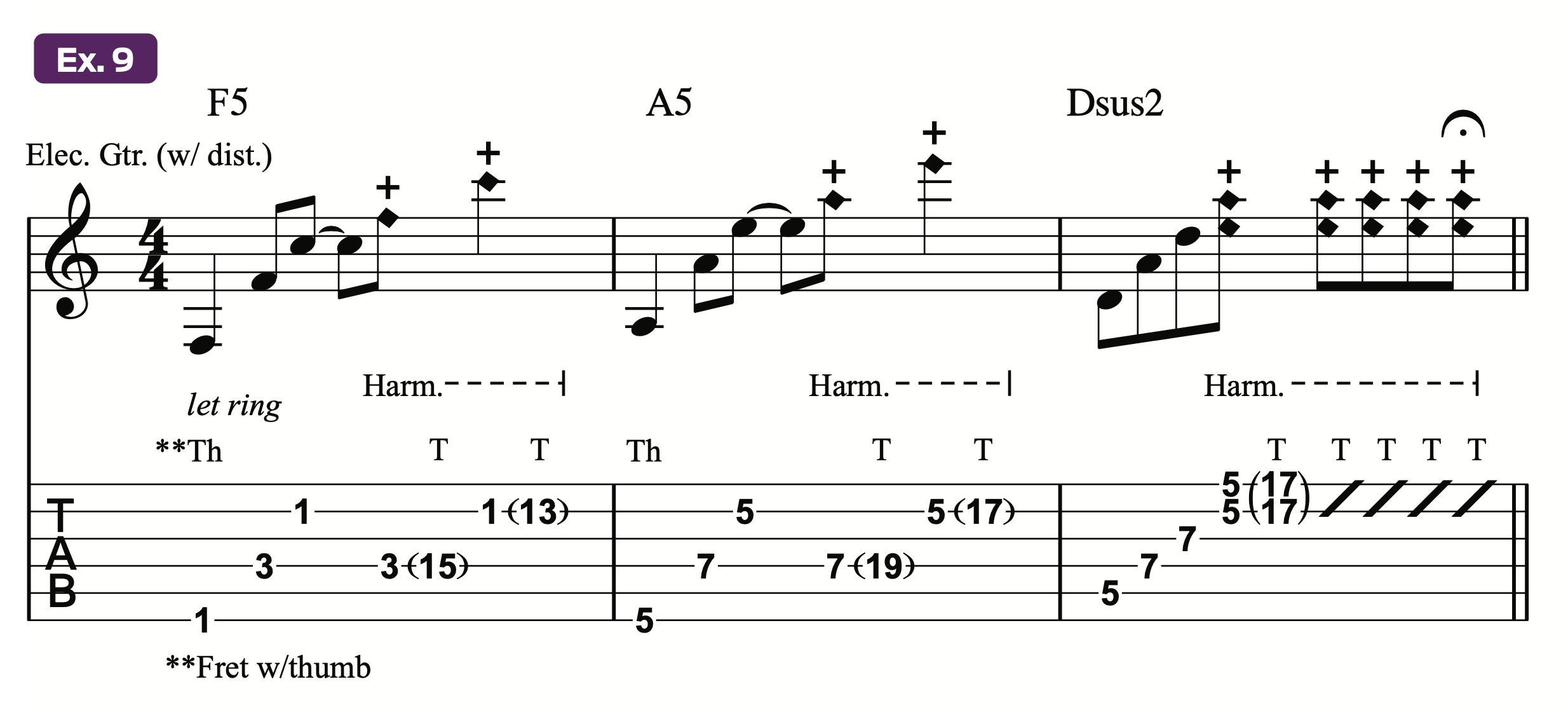
Let your fret-hand ring finger, playing the F on the 4th string, also dampen the 3rd string by lightly touching it. Having that dampened string allows you to be freer with how you tap, because you won’t need to be so careful about solely tapping the string indicated and avoiding unwanted sounds from occurring. For example, when you tap the 4th-string F harmonic on the upbeat of beat 3, you can also tap the 3rd string, as it simply won’t sound a note.
Now let’s move away from harmonics and present ourselves with a new conundrum: What if, while playing fingerstyle, you suddenly wanted to play a passage that your sixth sense tells you would sound better played with the sharper attack of a pick?
In fact, guitarists like Fleetwood Mac’s Lindsey Buckingham have already tackled this seemingly thorny issue for us. In The Chain, for example, he creates a repetitive droning riff by striking the strings with his pick-hand fingernails, producing a similar percussive bite to what one would expect when using a pick.
Ex. 10 is informed by Buckingham’s playing during the song’s uptempo outro. To execute this phrase, simply strike the strings with your fingernails in a repeating downward motion.
Since it’s more of a broad movement, our new hack can again be used to deaden adjacent strings. Fretting the 2nd string with your middle finger throughout the phrase will allow you to then use your index finger behind it to deaden the 3rd and 4th strings, so as to avoid them accidentally sounding unwanted notes.
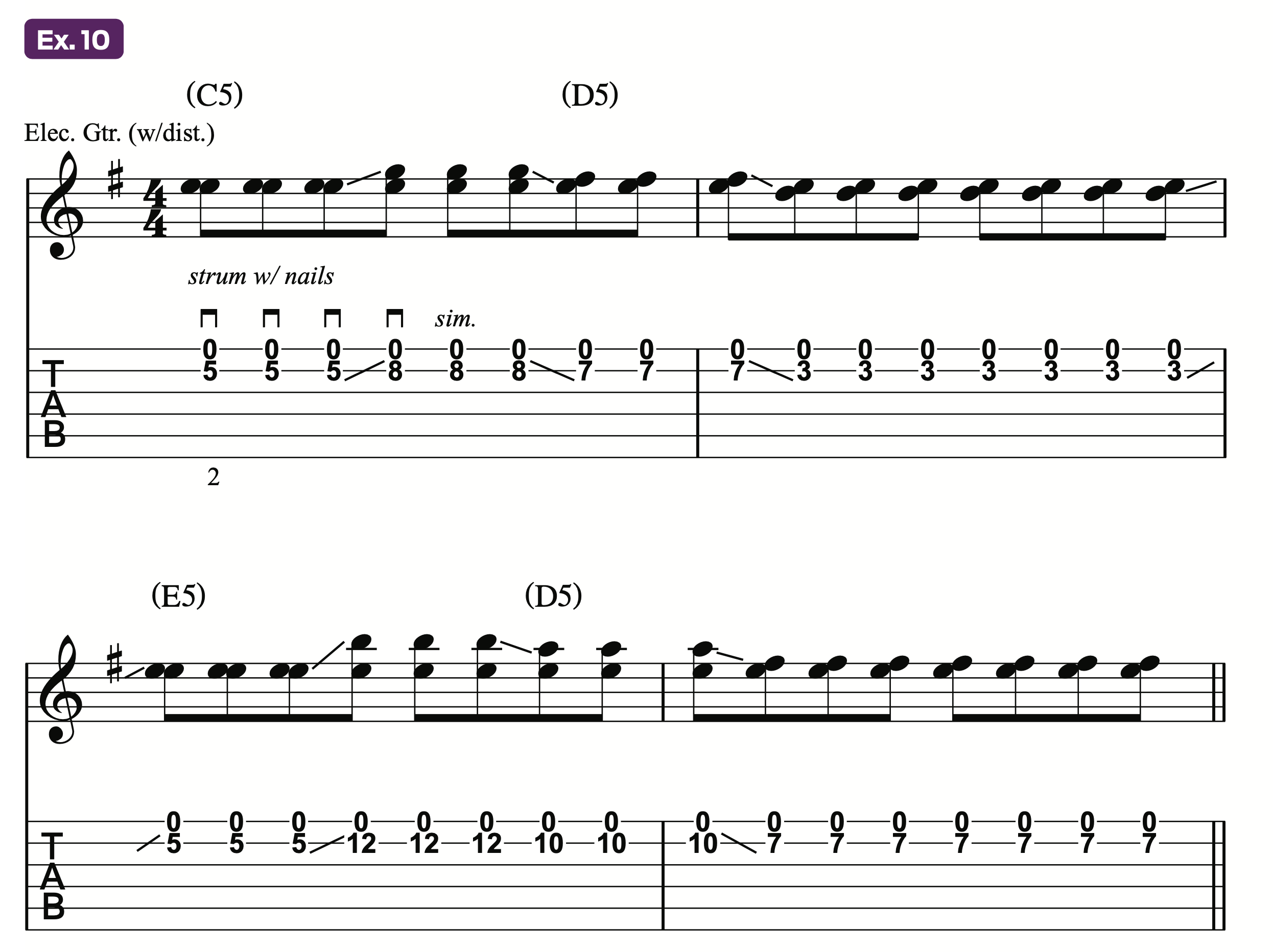
As before, deadening those strings allows you to strum more freely with tapping, instead of having to concentrate on striking only the strings indicated, and this can in turn add some welcome grit.
Let’s close out our fingerstyle adventure by tackling some different, interesting grooves and techniques. The remaining musical examples are from Gilmore’s impressive cache of ideas.
One of the great things about fingerstyle playing is that you can play both melody and accompaniment simultaneously.
Ex. 11 introduces this concept with a bluesy melody (up-stemmed) over a static bass line (down-stemmed). You’ll need to do some palm muting here, but only for the bass notes. To accomplish this, rest your pick hand on your guitar’s bridge as you normally would to create palm muting with a pick, but lift the hand partially so it touches only the lower strings, leaving the melody notes unmuted.
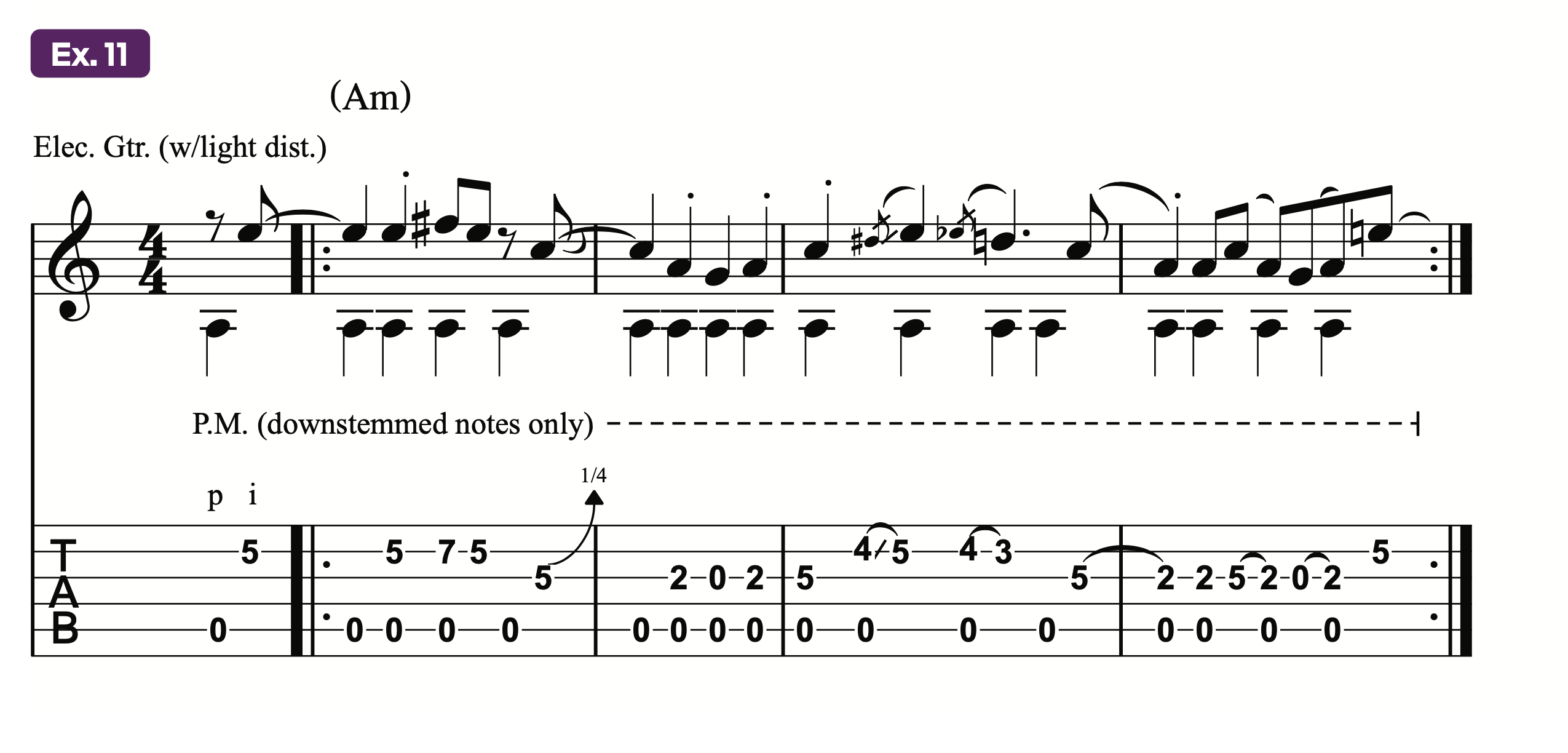
You can simply pick the entire melody with your index finger, as Gilmore does, or use your middle if you prefer. Lastly, if you’ve already played the Mark Knopfler–inspired Ex. 5 from part 1, you’ll have no trouble negotiating the final bar, which involves picking bass notes while simultaneously performing melodic hammer-ons and pull-offs.
You might remember how in the previous lesson we looked at a percussive thumb slap technique (from Ex. 3b). Ex. 12 applies this technique with a different kind of groove.
Start by ignoring everything except the bass line, which is much sparser than our previous example, here creating a pattern much like what a drummer would play on a bass drum. Skipping the pickup notes, simply sound a low E on beats 1 and 3, adding an additional note on beat 2’s eighth-note upbeat to help propel things along. (Omit the thumb slaps on beats 2 and 4 for now, substituting a rest.) Then simply repeat the same pattern for the second bar.
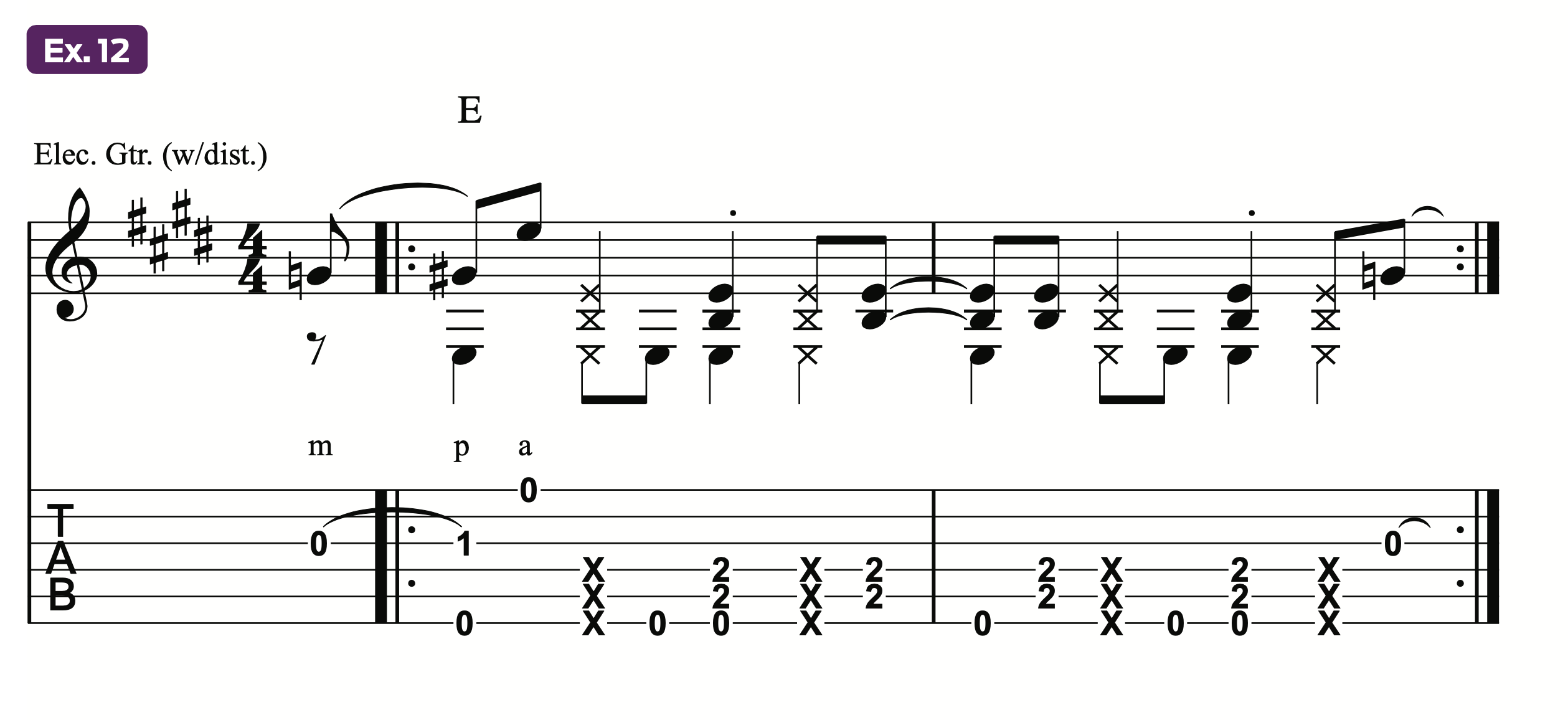
Now that we’ve got the bass line going, let’s complete our “rhythm section” by adding percussive slaps to simulate the classic backbeat a drummer would create by hitting the snare drum on 2 and 4.
First, let’s add the thumb slap on beat 2, hitting the top of the 6th string so as to set yourself up to pluck it on beat 2’s upbeat. Now, along with your thumb, simultaneously slap the higher strings with your fingernails to create even more of a percussive thwap, as Gilmore demonstrates in our video for this example. Once you’re grooving, wrap things up by adding the initial bluesy lick and the low double-stops.
Ex. 13 employs the same techniques, but this time with a funkier rhythm. Again, let’s begin by simply playing the down-stemmed notes, all on the 5th string. But here, we’ll include the thumb slaps right off the bat.
Start out slowly and, as in the previous example, hitting the top of the deadened 5th string will set you up for the subsequent pluck. When you’re feeling the groove, add in the up-stemmed notes and try increasing the tempo. Play it as slowly as you need to at first so that you can acquire the necessary coordination and make it through without any mistakes, then take the tempo up a notch.

Let’s bring in a bit of country flavor with a technique commonly known as “chicken pickin’.” It’s most often executed using hybrid picking, but for our purposes, we can summon the same pluckiness without using a pick. Now let’s bring things home with a fun double-stops lick, presented in Ex. 14.

Note that, here, the deadened notes aren’t slapped; they refer to notes plucked normally, all with the thumb, which are deadened with your fret hand. Alternating with the double-stops, these muted notes rhythmically propel the lick forward while adding a subtle funkiness. Check out Michael Lee Firkins’ 1990 shred classic Laughing Stacks for a taste of how he seamlessly blends metal and country, albeit with a pick.
Maybe the best part of having explored these new fingerstyle techniques is that now, whenever you switch back to your pick, it’ll be even more fun to have its signature attack back. Music, at its core, is about contrasting sounds and textures, so being able to vary your approach will always serve you well.
Jeff Jacobson is a guitarist, songwriter and veteran music transcriber, with hundreds of published credits. For information on virtual guitar lessons and custom transcriptions, feel free to reach out to Jeff on Instagram @jjmusicmentor or visit jeffjacobson.net.
All examples © copyright 2023 Gilber Gilmore. All rights reserved. Used by permission.
Get The Pick Newsletter
All the latest guitar news, interviews, lessons, reviews, deals and more, direct to your inbox!
Jeff Jacobson is a guitarist, songwriter and veteran music transcriber, with hundreds of published credits. For information on virtual guitar and songwriting lessons or custom transcriptions, reach out to Jeff on Twitter @jeffjacobsonmusic or visit jeffjacobson.net.
“Write for five minutes a day. I mean, who can’t manage that?” Mike Stern's top five guitar tips include one simple fix to help you develop your personal guitar style
"It’s like you’re making a statement. And you never know where it’ll lead." Pete Thorn shares the tip that convinced Joe Satriani he was the right guitarist for the SatchVai Band





















